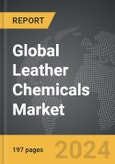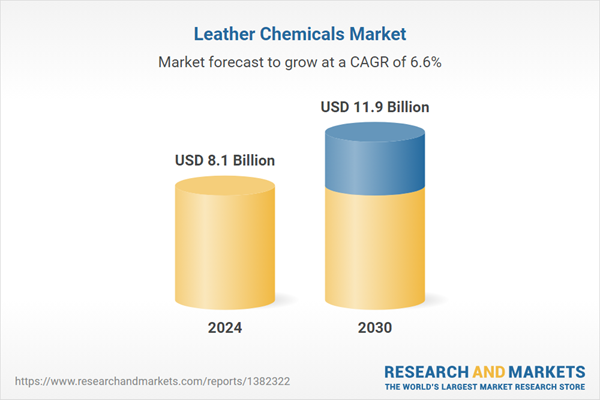The global market for Leather Chemicals was valued at US$8.1 Billion in 2024 and is projected to reach US$11.9 Billion by 2030, growing at a CAGR of 6.6% from 2024 to 2030. This comprehensive report provides an in-depth analysis of market trends, drivers, and forecasts, helping you make informed business decisions. The report includes the most recent global tariff developments and how they impact the Leather Chemicals market.
Segments: Process Type (Tanning & Dyeing, Beamhouse, Finishing); End-Use (Footwear, Textile & Fashion, Furniture & Upholstery, Automotive, Other End-Uses).
Geographic Regions/Countries: World; USA; Canada; Japan; China; Europe; France; Germany; Italy; UK; Spain; Russia; Rest of Europe; Asia-Pacific; Australia; India; South Korea; Rest of Asia-Pacific; Latin America; Argentina; Brazil; Mexico; Rest of Latin America; Middle East; Iran; Israel; Saudi Arabia; UAE; Rest of Middle East; Africa.
The analysts continuously track trade developments worldwide, drawing insights from leading global economists and over 200 industry and policy institutions, including think tanks, trade organizations, and national economic advisory bodies. This intelligence is integrated into forecasting models to provide timely, data-driven analysis of emerging risks and opportunities.
Global Leather Chemicals Market - Key Trends & Drivers Summarized
What Are Leather Chemicals and Why Are They Crucial?
Leather chemicals play an indispensable role in the leather production process, which transforms raw animal hides into durable and versatile leather products. These chemicals are utilized at various stages of leather manufacturing, including tanning, dyeing, and finishing. Tanning agents, such as chromium sulfate and vegetable tannins, stabilize the collagen fibers in hides, making them resistant to decomposition and imparting desired qualities such as flexibility and strength. Dyeing agents provide the leather with a wide range of colors, while finishing chemicals enhance the leather's appearance and durability, providing water resistance, gloss, and texture. Without these chemicals, leather would not have the properties that make it suitable for use in fashion, upholstery, and industrial applications.How Do Environmental and Safety Concerns Shape the Use of Leather Chemicals?
The leather industry has faced significant scrutiny due to the environmental impact and safety concerns associated with traditional leather chemicals. Conventional tanning processes, particularly those using chromium salts, can lead to the release of hazardous waste into the environment if not managed properly. This has prompted a shift towards more sustainable and eco-friendly alternatives. Increasingly, manufacturers are adopting vegetable tanning methods, which use natural tannins derived from plants, and chrome-free tanning processes, which eliminate the use of toxic heavy metals. Additionally, advancements in chemical formulations are leading to the development of biodegradable and less polluting finishing agents, ensuring that the leather industry can maintain high standards of environmental compliance while meeting consumer demand for eco-friendly products.What Are the Latest Innovations in Leather Chemical Technology?
Recent innovations in leather chemical technology are revolutionizing the industry by enhancing the efficiency and sustainability of leather production. One notable development is the use of enzyme-based tanning agents, which offer a safer and more environmentally friendly alternative to traditional chemicals. These enzymes facilitate the tanning process at lower temperatures and pH levels, reducing energy consumption and chemical waste. Nanotechnology is also making significant inroads, with nano-coatings providing superior protection against water, stains, and microbial growth. Additionally, digital printing technology allows for precise application of dyes and finishes, minimizing waste and enabling customized designs. These technological advancements are not only improving the quality and performance of leather products but also aligning the industry with global sustainability goals.What Drives the Growth in the Leather Chemicals Market?
The growth in the leather chemicals market is driven by several factors, including technological advancements, increasing demand for high-quality leather products, and stringent environmental regulations. Innovations in chemical formulations and application techniques are enhancing the efficiency and sustainability of leather production, catering to the rising consumer preference for eco-friendly products. The automotive and fashion industries, which are significant consumers of leather, are driving demand for superior finishing chemicals that enhance the durability and aesthetic appeal of leather goods. Additionally, regulatory pressures to reduce the environmental impact of leather production are prompting manufacturers to adopt cleaner and safer chemical processes. The expanding middle-class population in emerging markets is also contributing to the growth, as increased disposable income boosts demand for luxury leather products. These factors collectively ensure the robust expansion of the leather chemicals market, reflecting the industry's commitment to innovation and sustainability.Report Scope
The report analyzes the Leather Chemicals market, presented in terms of units. The analysis covers the key segments and geographic regions outlined below.Segments: Process Type (Tanning & Dyeing, Beamhouse, Finishing); End-Use (Footwear, Textile & Fashion, Furniture & Upholstery, Automotive, Other End-Uses).
Geographic Regions/Countries: World; USA; Canada; Japan; China; Europe; France; Germany; Italy; UK; Spain; Russia; Rest of Europe; Asia-Pacific; Australia; India; South Korea; Rest of Asia-Pacific; Latin America; Argentina; Brazil; Mexico; Rest of Latin America; Middle East; Iran; Israel; Saudi Arabia; UAE; Rest of Middle East; Africa.
Key Insights:
- Market Growth: Understand the significant growth trajectory of the Tanning & Dyeing segment, which is expected to reach US$6.0 Billion by 2030 with a CAGR of a 7.0%. The Beamhouse segment is also set to grow at 6.3% CAGR over the analysis period.
- Regional Analysis: Gain insights into the U.S. market, valued at $1.5 Billion in 2024, and China, forecasted to grow at an impressive 8.9% CAGR to reach $2.6 Billion by 2030. Discover growth trends in other key regions, including Japan, Canada, Germany, and the Asia-Pacific.
Why You Should Buy This Report:
- Detailed Market Analysis: Access a thorough analysis of the Global Leather Chemicals Market, covering all major geographic regions and market segments.
- Competitive Insights: Get an overview of the competitive landscape, including the market presence of major players across different geographies.
- Future Trends and Drivers: Understand the key trends and drivers shaping the future of the Global Leather Chemicals Market.
- Actionable Insights: Benefit from actionable insights that can help you identify new revenue opportunities and make strategic business decisions.
Key Questions Answered:
- How is the Global Leather Chemicals Market expected to evolve by 2030?
- What are the main drivers and restraints affecting the market?
- Which market segments will grow the most over the forecast period?
- How will market shares for different regions and segments change by 2030?
- Who are the leading players in the market, and what are their prospects?
Report Features:
- Comprehensive Market Data: Independent analysis of annual sales and market forecasts in US$ Million from 2024 to 2030.
- In-Depth Regional Analysis: Detailed insights into key markets, including the U.S., China, Japan, Canada, Europe, Asia-Pacific, Latin America, Middle East, and Africa.
- Company Profiles: Coverage of players such as Arkema S.A., Chemtan Company, Inc., DyStar Singapore Pte. Ltd., Evonik Industries AG, Indofil Industries Limited and more.
- Complimentary Updates: Receive free report updates for one year to keep you informed of the latest market developments.
Some of the 89 companies featured in this Leather Chemicals market report include:
- Arkema S.A.
- Chemtan Company, Inc.
- DyStar Singapore Pte. Ltd.
- Evonik Industries AG
- Indofil Industries Limited
- Saudi Basic Industries Corporation
- Schill+Seilacher GmbH
- Solvay S.A.
- Stahl Holdings B.V.
- Texapel S.L.
- TFL Ledertechnik GmbH
- Zschimmer & Schwarz GmbH & Co. KG
Tariff Impact Analysis: Key Insights for 2025
Global tariff negotiations across 180+ countries are reshaping supply chains, costs, and competitiveness. This report reflects the latest developments as of April 2025 and incorporates forward-looking insights into the market outlook.The analysts continuously track trade developments worldwide, drawing insights from leading global economists and over 200 industry and policy institutions, including think tanks, trade organizations, and national economic advisory bodies. This intelligence is integrated into forecasting models to provide timely, data-driven analysis of emerging risks and opportunities.
What’s Included in This Edition:
- Tariff-adjusted market forecasts by region and segment
- Analysis of cost and supply chain implications by sourcing and trade exposure
- Strategic insights into geographic shifts
Buyers receive a free July 2025 update with:
- Finalized tariff impacts and new trade agreement effects
- Updated projections reflecting global sourcing and cost shifts
- Expanded country-specific coverage across the industry
Table of Contents
I. METHODOLOGYMII. EXECUTIVE SUMMARY2. FOCUS ON SELECT PLAYERSIII. MARKET ANALYSISCANADAITALYSPAINRUSSIAREST OF EUROPESOUTH KOREAREST OF ASIA-PACIFICARGENTINABRAZILMEXICOREST OF LATIN AMERICAIRANISRAELSAUDI ARABIAUNITED ARAB EMIRATESREST OF MIDDLE EASTIV. COMPETITION
1. MARKET OVERVIEW
3. MARKET TRENDS & DRIVERS
4. GLOBAL MARKET PERSPECTIVE
UNITED STATES
JAPAN
CHINA
EUROPE
FRANCE
GERMANY
UNITED KINGDOM
ASIA-PACIFIC
AUSTRALIA
INDIA
LATIN AMERICA
MIDDLE EAST
AFRICA
Companies Mentioned (Partial List)
A selection of companies mentioned in this report includes, but is not limited to:
- Arkema S.A.
- Chemtan Company, Inc.
- DyStar Singapore Pte. Ltd.
- Evonik Industries AG
- Indofil Industries Limited
- Saudi Basic Industries Corporation
- Schill+Seilacher GmbH
- Solvay S.A.
- Stahl Holdings B.V.
- Texapel S.L.
- TFL Ledertechnik GmbH
- Zschimmer & Schwarz GmbH & Co. KG
Table Information
| Report Attribute | Details |
|---|---|
| No. of Pages | 437 |
| Published | April 2025 |
| Forecast Period | 2024 - 2030 |
| Estimated Market Value ( USD | $ 8.1 Billion |
| Forecasted Market Value ( USD | $ 11.9 Billion |
| Compound Annual Growth Rate | 6.6% |
| Regions Covered | Global |









